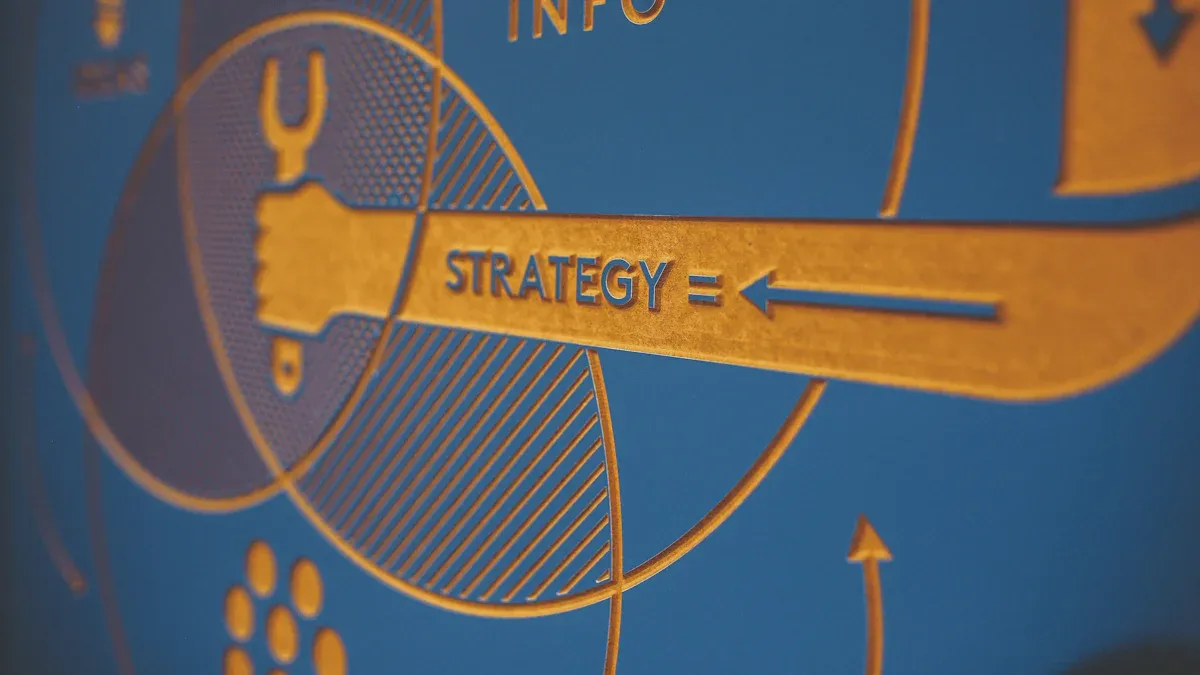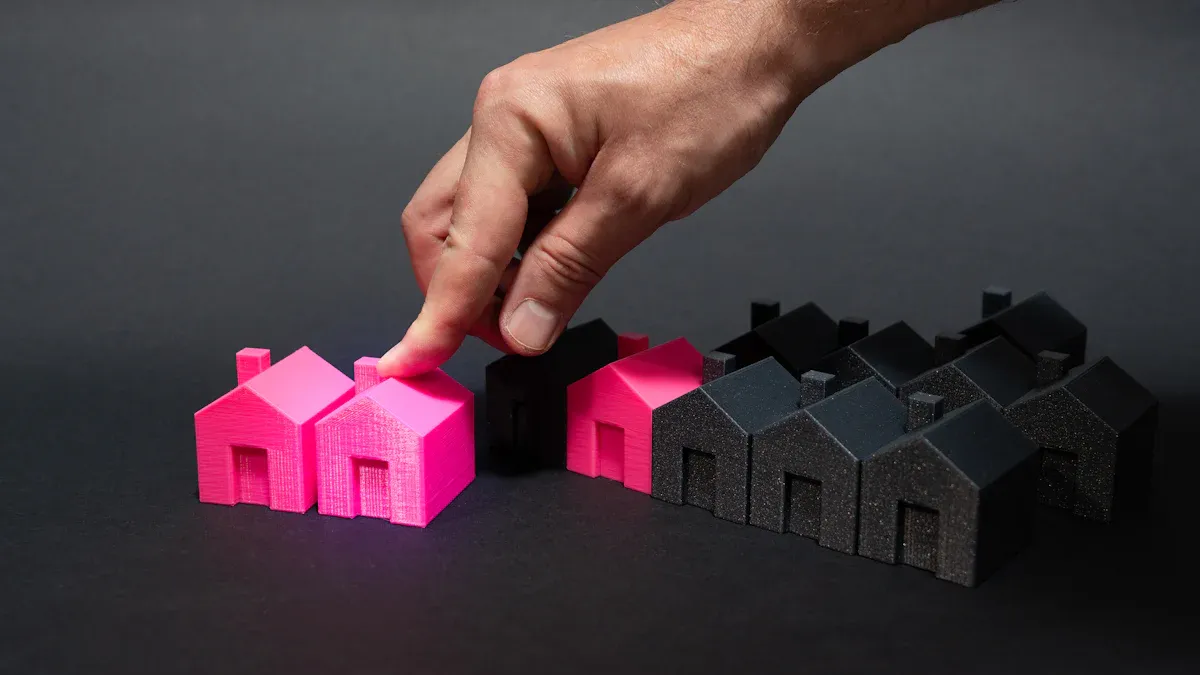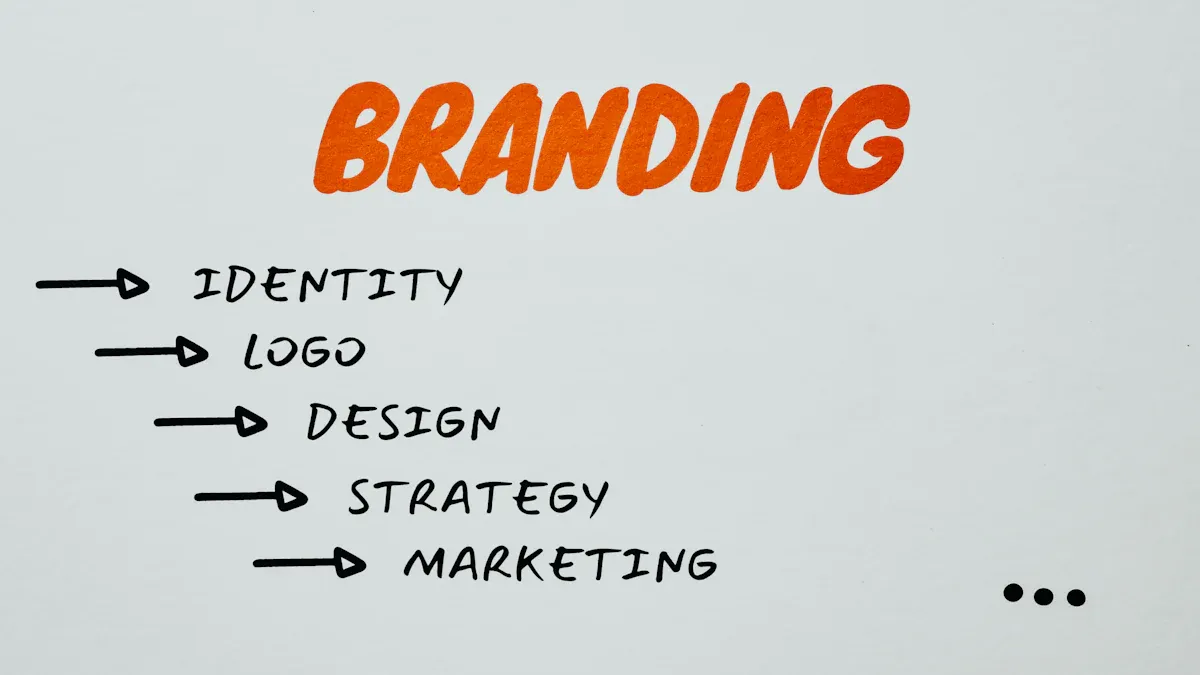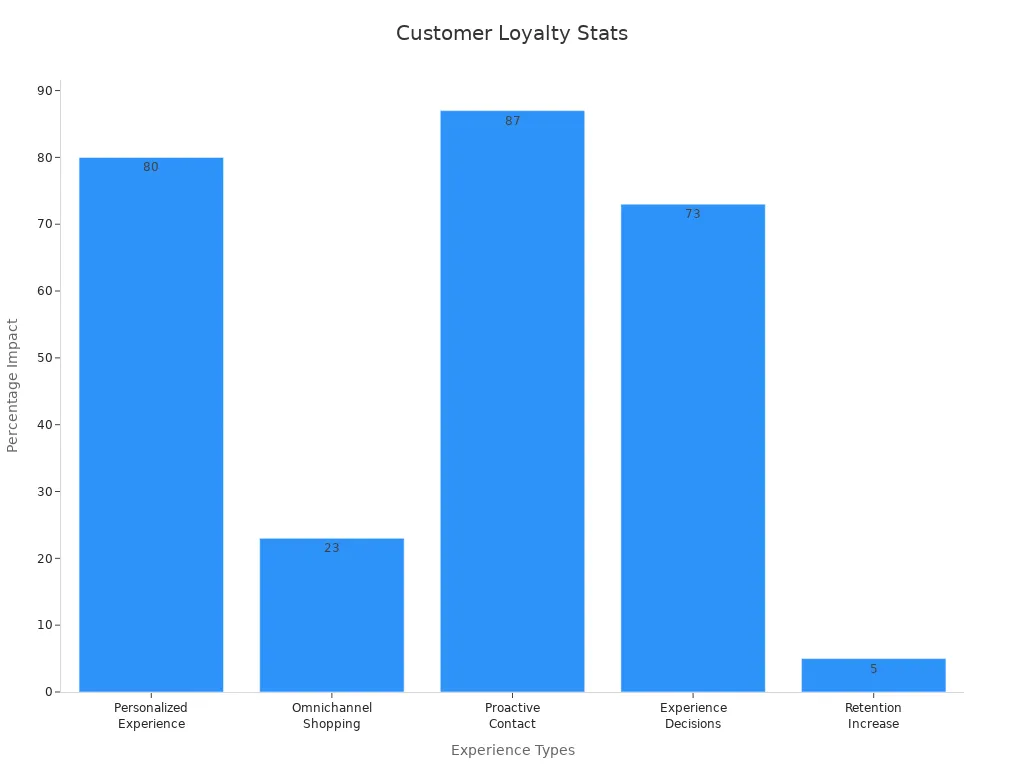Effective strategies to differentiate your brand in 2025

The tough competition in 2025 necessitates smart branding ideas that focus on Brand Differentiation. These ideas help grab attention and maintain customer loyalty. People now expect more from brands. For example:
75% of shoppers prefer brands with custom content.
43% of loyal customers spend more on their favorite brands.
Companies with effective loyalty programs grow 2.5 times faster.
To stand out, develop unique branding plans that align with your brand's goals. Enhance your brand's visibility and connect with people on an emotional level. Personal touches and emotional engagement are now essential.
Craft compelling brand stories

The power of storytelling in brand differentiation
Telling stories is a key way to make your brand unique. It helps you connect deeply with your audience. Studies show 79% of people like brands that share stories, especially Millennials aged 18 to 34. Stories make your brand stand out by building real connections. They bring out feelings like laughter or sadness, which keeps people interested and loyal. Over half of buyers (55%) say good stories affect their choice to buy.
Using stories lets you share your brand’s purpose clearly. This method attracts 64% of people who prefer brands with strong values. By talking about your journey, beliefs, or goals, you can make your brand unforgettable and relatable.
Creating emotional connections through narratives
Emotions are the key to great storytelling. People remember stories 22 times better than facts. This makes stories a strong way to connect with your audience. For example, you can tell stories about your customers’ dreams or struggles. When they see themselves in your story, they feel closer to your brand.
Pictures, videos, and charts can make your stories even better. These tools make your message fun and easy to follow. Brands that focus on emotional storytelling often include their products in stories that match their customers’ lives. This builds loyalty and trust.
Examples of successful brand storytelling in 2025
Some brands use storytelling to achieve big success. Coca-Cola’s story-based ads boosted sales by 3.6%. Highrise doubled signups by sharing a customer’s story on its website. Facebook’s video ads with quick stories get more attention.
In 2025, brands like Airbnb, Spotify, and Google lead in storytelling. Airbnb uses data to share stories about community and kindness. Spotify’s Wrapped feature creates personal music stories for users. Google’s "Year in Search" shows global trends, making its brand feel closer to people. These examples show how storytelling can grow brands and build strong connections.
Offer unique products
Finding gaps in the market and customer needs
The first step to offering unique products is knowing what customers want but can’t find. You can learn this by studying the market carefully. Use surveys, interviews, and social media to spot problems people face. For example, focus groups often show common complaints about current products. Keyword research can also reveal issues people talk about online.
Watching how people use products in real life helps too. Ethnography lets you see their habits and struggles. Journey mapping shows their experiences and problems step by step. These tools help you follow changing trends and improve your products. Companies that study customer data often find new ideas for better solutions.
Tip: Use data tools to guess what customers will want next. This helps you plan smarter and make better choices for your unique products.
Standing out with special designs and teamwork
Special designs and working with others can make your brand different. Teaming up with artists, influencers, or brands creates exciting products. For example, limited-edition items often get people talking and bring in new buyers. After launching, check things like clicks, visits, and sales to see how well it worked.
To stay ahead, make new products faster. This gives you an edge over others. Also, smooth design processes and happy partners show good teamwork. When partners are satisfied, it means the designs meet customer needs.
Quick launches: Faster product releases help you compete better.
Good designs: Simple steps lead to great results.
Happy partners: Satisfied partners mean strong teamwork.
Matching products with your brand’s values
When your products match your brand’s values, customers feel closer to you. Studies show 82% of shoppers like brands that share their beliefs. If customers see their values in your products, they stay loyal.
For example, if your brand cares about the planet, eco-friendly products will connect with your audience. But if your products don’t match your values, customers might leave. Surveys say 75% of shoppers stop buying from brands with value conflicts.

Always check if your products show your brand’s unique values. This helps your brand stand out and keeps customers coming back.
Embrace sustainability in your brand strategy

Why sustainability matters for brands in 2025
Sustainability is a big deal for brands in 2025. People want companies to care about the planet and society. Studies show 64% of people think businesses should fight climate problems. Also, 50% of shoppers say sustainability is a top reason they buy. If brands ignore this, 76% of people might stop supporting them.
Being sustainable also helps brands grow faster. Brands that focus on sustainability grew 20% more in four years. This shows that caring for the planet can boost profits and make brands stronger. By choosing sustainability, your brand can lead in both innovation and doing good.
Using eco-friendly materials and fair practices
Using eco-friendly materials is important for brands today. Big companies like Unilever and Patagonia use better packaging. Starbucks gets 99% of its coffee from fair sources. Apple wants to be carbon neutral, and IKEA takes back old furniture to recycle it.
You can do similar things to make your brand greener. Use recycled or renewable materials in your products. Switch from plastic to biodegradable options. Support projects that reduce carbon pollution. Be honest about your efforts by showing certifications or labels. These actions can make your brand popular with eco-friendly shoppers.
Sharing your sustainability efforts clearly
Telling people about your green efforts is very important. Show how your brand cares about the same things they do. For example, experts in 2024 said clear goals and messages work best. Use numbers to show how well your plans are working.
Pictures and videos can make your message stronger. Share stories about your eco-friendly work through infographics or videos. Work with influencers who care about the planet to reach more people. Teach others about being responsible shoppers using blogs or social media. By being open and engaging, you can earn trust and stand out in the market.
Personalize your marketing strategy
Using AI and data for custom content
AI changes how brands make personalized content. It studies customer data to create messages people like. AI can guess what people will buy, suggest items, and adjust messages to fit their tastes. This makes customers more interested and improves your marketing results.
Numbers show how AI helps personalization work better:
Metric | Improvement Percentage |
|---|---|
Conversion Rate | 41% higher |
Engagement Metrics | 31% higher |
Content ROI | 68% higher |
Email Open Rates | 59% higher |
Click-Through Rates | 27% higher |
Content Distribution Efficiency | 3.7x more qualified prospects |
SEO First-Page Ranking Speed | 43% faster |
Marketing Team Productivity | 37% faster |
These stats prove AI makes marketing smarter and more effective.
Dividing audiences for better messaging
Audience segmentation splits customers into smaller groups. Each group shares similar traits. This helps brands focus on what each group needs. By learning about these groups, brands find new ways to connect and send messages that matter.
Why audience segmentation works:
Targets specific groups for better focus.
Puts customers first in your strategy.
Finds new ideas through detailed research.
Tracks trends to stay ahead of competitors.
Keeps loyal customers and attracts new ones with custom content.
This method saves time, boosts sales, and creates products people want. It builds stronger customer bonds and makes your brand stand out.
Real examples of personalized campaigns
Brands show how personalization leads to success. Starbucks earned $2.56 billion using its rewards app, selling 6 million items monthly. Matsmart grew website sales by 84% with Facebook ads. Netflix used interactive campaigns to keep users engaged.
Other brands also succeeded:
Marie Curie gained more sign-ups with location-based maps.
YW Istanbul grew Instagram followers from 152K to 1M with unique posts.
SAP made custom plans for top clients, earning $27 million in new deals.
These examples prove that personalized marketing boosts customer interest and helps brands grow.
Build customer loyalty through exceptional experiences
Giving great customer service to build trust
Good customer service helps people trust your brand. When you care about their needs, they feel special. Research shows 43% of people buy more after good service. Also, 83% stay loyal when complaints are solved well. Respecting their time matters too. About two-thirds of US adults say quick help makes a big difference.
To build trust, talk to customers before problems grow. Studies show 87% like brands that fix issues early. This lowers the chance of losing customers and keeps them coming back. By always giving great service, you can earn their trust and repeat business.
Using reviews and testimonials to show proof
Reviews and testimonials help people trust your brand. Many customers read reviews before buying. In fact, 61% check online reviews first, and 90% say reviews affect their choices. Happy customers’ feedback makes your brand look reliable.
Ask customers to share their thoughts in reviews or testimonials. Show these on your website and social media to gain trust. When new customers see positive comments, they feel confident about your brand. This builds your reputation and helps you sell more.
Making referral programs to encourage sharing
Referral programs get customers to tell others about your brand. They offer rewards to both the referrer and the new customer. Stats show 78% of programs give benefits to both sides. Also, 44% join to earn prizes or discounts.
Word-of-mouth spreads your brand faster. It boosts marketing by 54% and gives a high return on investment. Create simple programs with good rewards that match your brand’s values. This turns happy customers into loyal supporters who share your brand with others.

Use custom merchandise to stand out
How custom merchandise helps your brand shine
Custom merchandise is key to making your brand unique. Special products catch attention and attract people who want something different. Exclusive items make your brand look creative and easy to remember. Customers often think unique products are worth more, so they’re willing to pay extra. Offering rare items also keeps customers coming back because they can’t find them anywhere else.
Tip: Show your brand’s style and values with custom merchandise. This leaves a strong impression and builds better connections with your audience.
Why print-on-demand services like Yoycol are helpful
Print-on-demand services, like Yoycol, make creating custom items simple. These platforms let you design products without spending a lot upfront. You can try new ideas and products with less risk. Print-on-demand also speeds up production, so you can follow trends and meet customer needs faster.
Evidence Type | Statistic/Insight |
|---|---|
Loyalty Boost | 83% of people stay loyal after getting a promo item. |
Brand Recall | 90% remember the name of a company that gave them a promo product. |
Recognition from Swag | 76.1% recall a brand due to swag received in the past year. |
Usage Frequency | 73% use giveaways weekly, and 45.2% use them daily. |
Marketing Spend | Companies spend 3x more on swag than search ads, totaling $17 billion yearly. |
These numbers show how custom merchandise improves branding, loyalty, and visibility.
Adding personalization and sustainability to custom products
Personalized and eco-friendly products make your brand even better. Custom items create special moments for customers, making them feel appreciated. Research shows 85% of people engage with a brand after getting a promo product. Marketers using personalization see 20% higher sales. Personalized products also lower returns by 40% because they fit customer needs better.
Sustainability makes your brand stand out even more. Using eco-friendly materials and fair practices appeals to green-minded shoppers. Sustainable products show you care about the planet, which builds trust and loyalty.
Note: Mixing personalization with sustainability improves your marketing and shows your brand is modern and responsible.
Making your brand stand out in 2025 takes smart planning. Six key strategies—telling stories, offering unique products, being eco-friendly, personalizing marketing, giving great experiences, and using custom items—can help your brand succeed. These ideas make your brand stronger and connect better with people.
Being creative, focused on customers, and ready to change is important now. Businesses that stay flexible do well by following trends and meeting customer needs. For example:
Feedback systems help improve customer happiness.
Testing ideas makes marketing work better.
Being flexible keeps businesses growing and relevant.
Strategy Type | What It Does |
|---|---|
Feedback Systems | Real-time tools help brands improve products and services. |
Flexibility | Changing with trends helps brands grow and stay important. |
Standing Out | Using new ideas and great customer care makes brands unique. |
Using these strategies can make your brand strong and successful in a crowded market. Start now to prepare your brand for lasting success.
FAQ
What does brand differentiation mean, and why is it key in 2025?
Brand differentiation makes your brand special compared to others. It helps you get noticed, gain customers, and keep them loyal. In 2025, crowded markets make standing out very important for success.
How can telling stories help my brand get noticed?
Stories connect your brand to feelings. People remember stories more than facts. Sharing your brand’s values or journey builds trust and keeps people interested.
Why is sustainability good for my brand?
Sustainability attracts shoppers who care about the planet. Using eco-friendly materials and fair practices shows you care. This builds trust and improves your brand’s image.
How does personalized marketing help my brand?
Personalized marketing sends messages that match your audience’s needs. It boosts interest, increases sales, and keeps customers loyal. Tools like AI make this easier and smarter.
Why is custom merchandise helpful for my brand?
Custom merchandise makes your brand stand out. Special items create strong connections and keep customers loyal. Print-on-demand services make it easy to offer unique and green products.
See Also
Explore The Leading Graphic Design Trends For 2025
Effective Marketing Tactics For Boosting Summer Sales In June
Discover Five Innovative Dropshipping Business Concepts For 2025

